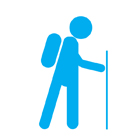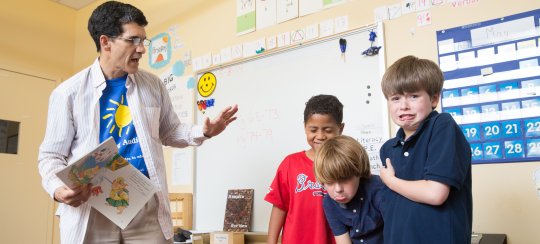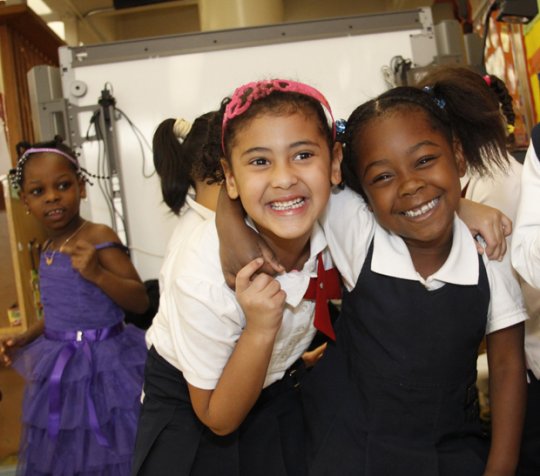Unit 4: Lesson 10
Create Themes for Additional Characters; TRAIL Marker #2
LITERACY OBJECTIVE
By the end of this lesson students will be able to draw upon chapter notes and reflections to create a musical theme that represents the main character.
LITERACY "I CAN" STATEMENT
"I can identify clues in the story that tell me about the character and make notes about the things I am thinking while I read; I can identify a theme for Seedfolks."
LESSON OVERVIEW
*To break the lesson into smaller chunks, pause after Step 6 and resume the following day with a brief rehearsal before the presentations.
Standards Alignment
Reading Standards (Literature)
RL 3.1: Ask and answer questions to demonstrate understanding of a text, referring explicitly to the text as the basis for the answers.
RL 3.2: Recount stories, including fables, folktales, and myths from diverse cultures; determine the central message, lesson, or moral and explain how it is conveyed through key details in the text.
RL 3.3: Describe characters in a story (e.g., their traits, motivations, or feelings) and explain how their actions contribute to the sequence of events.
RL 4.1: Refer to details and examples in a text when explaining what the text says explicitly and when drawing inferences from the text.
RL 4.2: Determine a theme of a story, drama, or poem from details in the text; summarize the text.
RL 4.3: Describe in depth a character, setting, or event in a story or drama, drawing on specific details in the text (e.g., a character’s thoughts, words, or actions).
RL 5.2: Determine a theme of a story, drama, or poem from details in the text, including how characters in a story or drama respond to challenges or how the speaker in a poem reflects upon a topic; summarize the text.
RL 5.7: Analyze how visual and multimedia elements contribute to the meaning, tone, or beauty of a text (e.g., graphic novel, multimedia presentation of fiction, folktale, myth, poem).
Writing & Language
W 4.9: Draw evidence from literary or informational texts to support analysis, reflection, and research.
W 5.4: Produce clear and coherent writing in which the development and organization are appropriate to task, purpose, and audience.
W 5.9: Draw evidence from literary or informational texts to support analysis, reflection, and research.
Speaking & Listening
SL 3.1a: Come to discussions prepared, having read or studied required material; explicitly draw on that preparation and other information known about the topic to explore ideas under discussion.
SL 3.1b: Follow agreed-upon rules for discussions (e.g., gaining the floor in respectful ways, listening to others with care, speaking one at a time about the topics and texts under discussion).
SL 3.1c: Ask questions to check understanding of information presented, stay on topic, and link their comments to the remarks of others.
SL 3.1d: Explain their own ideas and understanding in light of the discussion.
SL 3.2: Determine the main ideas and supporting details of a text read aloud or information presented in diverse media and formats, including visually, quantitatively, and orally.
SL 3.3: Ask and answer questions about information from a speaker, offering appropriate elaboration and detail.
SL 3.6: Speak in complete sentences when appropriate to task and situation in order to provide requested detail or clarification.
SL 4.1a: Come to discussions prepared, having read or studied required material; explicitly draw on that preparation and other information known about the topic to explore ideas under discussion.
SL 4.1b: Follow agreed-upon rules for discussions and carry out assigned roles.
SL 4.1c: Pose and respond to specific questions to clarify or follow up on information, and make comments that contribute to the discussion and link to the remarks of others.
SL 4.1d: Review the key ideas expressed and explain their own ideas and understanding in light of the discussion.
SL 4.2: Paraphrase portions of a text read aloud or information presented in diverse media and formats, including visually, quantitatively, and orally.
SL 4.3: Identify the reasons and evidence a speaker provides to support particular points.
SL 4.6: Differentiate between contexts that call for formal English (e.g., presenting ideas) and situations where informal discourse is appropriate (e.g., small-group discussion); use formal English when appropriate to task and situation.
SL 5.1a: Come to discussions prepared, having read or studied required material; explicitly draw on that preparation and other information known about the topic to explore ideas under discussion.
SL 5.1b: Follow agreed-upon rules for discussions and carry out assigned roles.
SL 5.1c: Pose and respond to specific questions by making comments that contribute to the discussion and elaborate on the remarks of others.
SL 5.1d: Review the key ideas expressed and draw conclusions in light of information and knowledge gained from the discussions.
SL 5.2: Summarize a written text read aloud or information presented in diverse media and formats, including visually, quantitatively, and orally.
SL 5.3: Summarize the points a speaker makes and explain how each claim is supported by reasons and evidence.
SL 5.6: Adapt speech to a variety of contexts and tasks, using formal English when appropriate to task and situation.
Reading Standards (Literature)
RL 5.1: Quote accurately from a text when explaining what the text says explicitly and when drawing inferences from the text.
RL 5.3: Compare and contrast two or more characters, settings, or events in a story or drama, drawing on specific details in the text (e.g., how characters interact).
Writing & Language
W 3.4: With guidance and support from adults, produce writing in which the development and organization are appropriate to task and purpose.
W 3.10: Write routinely over extended time frames (time for research, reflection, and revision) and shorter time frames (a single sitting or a day or two) for a range of discipline-specific tasks, purposes, and audiences.
W 4.4: Produce clear and coherent writing in which the development and organization are appropriate to task, purpose, and audience.
W 4.10: Write routinely over extended time frames (time for research, reflection, and revision) and shorter time frames (a single sitting or a day or two) for a range of discipline-specific tasks, purposes, and audiences.
W 5.10: Write routinely over extended time frames (time for research, reflection, and revision) and shorter time frames (a single sitting or a day or two) for a range of discipline-specific tasks, purposes, and audiences.
L 3.1: Demonstrate command of the conventions of standard English grammar and usage when writing or speaking.
L 3.2: Demonstrate command of the conventions of standard English capitalization, punctuation, and spelling when writing.
L 4.1: Demonstrate command of the conventions of standard English grammar and usage when writing or speaking.
L 4.2: Demonstrate command of the conventions of standard English capitalization, punctuation, and spelling when writing.
L 5.1: Demonstrate command of the conventions of standard English grammar and usage when writing or speaking.
L 5.2: Demonstrate command of the conventions of standard English capitalization, punctuation, and spelling when writing.
Teaching Resources
-Music Instruments and Stations
Unit 5 includes the following Life & Learning Skills:
-Reflective thinking
-Creative problem-solving
-Critical and analytic thinking
-Collaboration Communication
 Differentiation Options
Differentiation Options
Differentiation Options will appear throughout the unit to suggest ways to scaffold or challenge student learning. Use the number of helping hands to select the level of differentiation that best supports student learning.


 Highest level of scaffolding. Select this option if students are learning strategies for the first time, if the text is challenging for them, or if students require more guidance during activities. Part 1 lessons are written for the highest level of scaffolding.
Highest level of scaffolding. Select this option if students are learning strategies for the first time, if the text is challenging for them, or if students require more guidance during activities. Part 1 lessons are written for the highest level of scaffolding.

 Moderate scaffolding. Select this option if students require some support comprehending the text or navigating the activity.
Moderate scaffolding. Select this option if students require some support comprehending the text or navigating the activity.

Least amount of scaffolding/Extending the instruction. Select this option if students are ready to work more independently, move more quickly through the material, or are ready for additional challenge.
 Leveraging Moments
Leveraging Moments
Key instructional steps where the arts are used to leverage literacy-learning (and vice versa) are marked with  . Smaller leveraging moments also occur throughout the lessons.
. Smaller leveraging moments also occur throughout the lessons.
Process: Give an overview of lesson objectives: Ensembles review what they learned about Gonzalo &/or Leona; create, share, and reflect on musical themes.
Differentiation Option: Visual Arts and Writing
A theme for Seedfolks will be the culminating art experience for each student produced by combining the symbolic gesture drawings for each of the characters into one final composition and by using the four Elements of Art – line, shape, color and value.
This composition will be done on a sheet of drawing paper, at least 12” x 18” in size using colored chalks and colored pencils.
The objective of this composition will be to synthesize the gestures that best represent the character traits and visualized images of each character in Seedfolks to develop and illustrate the collective theme of the text. The arrangement of images should be connected through color, line, value and shapes to illustrate the relationship of the four (or more) main characters and how they interact. Students may also incorporate visual clues and elements of the garden to thematically link them together as in the story.
The students’ illustrations will be exhibited, displayed with a written statement that articulates their decisions about the theme of the text and explains the text-to-text connections. The written statement may be separate or incorporated into the composition.
In arranging the composition, students should consider the Principles of Art:
The way the elements of art relate to each other and are organized in an artwork.
Arranging elements so that no one part of a work overpowers, or seems heavier
than any other part.
The concept behind the artwork, in this case the theme of Seedfolks, and how the colors, lines, shapes and values connect and lead the viewer’s eye through the composition. An analogy would be the way in which a conductor directs a wide variety of instruments in an orchestra to produce a symphony that is recognized as a single comprehensible piece. Unity is how well different parts of an artwork build on each other. (This term is often used in art classes.
The quality or state of having different forms or types, notable use of contrast, emphasis, difference in size and color.
The area of the composition to which the viewer’s eye is first drawn and the focal point of the art work. It is sometimes referred to as the center of interest, but it does not have to be in the exact middle of the composition.
Suggested Dialogue
"Today we’re going to review what we’ve learned about Gonzalo and Leona and then work in ensembles to compose themes with classroom instruments and found objects. If your ensemble read both chapters, you can choose which you want to work with for a musical theme."
"By the end of today’s lesson, you will be able to say, 'I can use my chapter notes and reflection to create a character theme that represents Gonzalo or Leona'.”
Process: Guide students to sit in Seedfolks Ensembles with their A4L Texts, A4L Notebooks, and a pen or pencil. Tell students to wait for the “Go” signal before moving. Guide ensembles to review their Seedfolks Character Chart and their reflections on the Reflection Journal. Have students get out their A4L Notebooks (
pages 18-20) and A4L Texts (
page 11-17).
Suggested Dialogue
Guiding Students to Review Gonzalo & Leona
Students move to sit with Seedfolks Ensembles.
"When I play the 'Go' signal, take your A4L Texts, A4L Notebooks, and a pen or pencil and move to sit with your Seedfolks Ensembles." (Play “Go” signal. Students move.)
Guide students to review Gonzalo & Leona.
"Open your A4L Notebooks to page 18 and open your A4L Texts to page 11 for Gonzalo or 14 for Leona. Use your Seedfolks Character Chart and the Reflection Journal to review what we’ve learned about Gonzalo and/or Leona in preparation to creating a musical theme. Spend a few minutes talking together with your ensemble about your character. What happened in the chapter? What kind of person is he/she?" (Ensembles review and discuss their character. If ensembles read both chapters, they should review both characters.)
Process: Transition to music and make connection to creating a character’s theme.
Suggested Dialogue
Composing Themes Using Found Objects
"Now that you’ve reflected on what you’ve learned about your character, you’re going to compose themes using found objects and classroom instruments."
 Process:
Process: Ensembles create a theme for either Gonzalo or Leona. If an ensemble read and annotated both chapters, allow them to choose which character to work with for a musical theme. Refer to the
Composer’s Questions and
Theme Criteria Charts to guide students in the creation of a theme. Highlight the range of options when composing a piece of music. The creative process requires students to experiment with instruments, dialogue, and revise. This may sound and look disorderly, but is an indication that students are engaged in the learning. Timing to compose themes is 15–20 minutes.
Coaching Tips for the Arts: Creating a Theme
When students are composing themes for their characters, keep in mind that this is an open-ended process without “correct” answers. Avoid making statements that reflect personal judgment of approval or disapproval. Take the role of guide—not arbiter of taste. Focus on the criteria.
Ask coaching questions and statements like:
-What characteristic are you interpreting? Show me that in your body. How do you feel when you are like that? What instrument sounds like that to you?
-How might you vary the sound of this instrument? Look at the “Elements of Music” chart. Can you vary dynamics, duration, pitch, or timbre?
-Does your theme sound the same each time your ensemble plays it? What can you do to:
Start together?
End together?
Know when to bring in the next instrument?
Know when to create the changes in dynamics, pitch, duration and timbre that you have planned?
-Use counting (1, 2, 3, 4) to help you know when to start and stop playing. For instance, the drum might start on “1,” and the sticks come in on “3.”
-Practice many times, so you can produce your sequence successfully each time you play it.
Theme Compositional Process
1. Review Character
Review your Seedfolks Character Chart and Reflection Journal. Think about what you have learned and what you would like to represent in the character’s theme.
2. Brainstorm Ideas into Sound
Review your “Sounds” column on your Character Chart. Talk with your ensemble about how you might translate these ideas into sound. Think about which instruments have the music elements you think will best represent the character. As a group, select four or five instruments from the music stations.
3. Experiment with Instruments
Try out each instrument and select new instruments if necessary.
4. Compose Theme
As you compose your theme, consider these “Composer’s Questions:”
-What characteristic, emotion, and/or transition are we interpreting?
-How will we begin and end the theme?
-Will we start and end with the same instrument; start with one instrument and end with another; or end with all our instruments?
-Which instruments will overlap?
-Which music elements (dynamics, duration, pitch, timbre) will change?
-Should we use counting off to help us organize our sounds?
-Have we fulfilled all the criteria for a theme?
Suggested Dialogue
Creating a Theme about your Character
"You will now work with your Seedfolks Ensemble to create a theme that represents what you have learned about your character. You will include the same theme criteria that were used for Kim’s, Ana’s, and Wendell’s themes."
"Let’s review the Theme Compositional Process. (Review process using Theme Compositional Process chart.) Look at the Theme Criteria Chart to help you remember what to include in the theme."
"You now have 15 minutes to create your themes. Feel free to revise your choices as you experiment and discover. And practice several times so you can play the theme the same way each time." (Ensembles compose and practice themes.)
Process: Ensembles work together to create graphic notations for their Gonzalo or Leona themes on
page 21 in their A4L Notebook. Review the process and guide students as necessary.
Suggested Dialogue
Developing your own Graphic Notation for your Theme
"Now it’s time to develop your own graphic notation for your ensemble’s musical theme for Gonzalo or Leona. Open your A4L Notebook to page 21. Here is a blank Notation Chart, just like the chart you used for our other characters. Work together to create graphic notations for all instruments playing in your theme. You have 10 minutes to write down your notation. I’ll check in after then to see if you need more time."
 Process:
Process: TRAIL Marker #2 is the second formative assessment in the unit. Students turn to
page 27 in their A4L Notebooks and reflect on their learning. Students share their reflections with one another. Sharing TRAIL Marker responses helps students think about what they are learning and helps teachers monitor student progress and reteach or extend based on what they observe.
Facilitating the Activity & Discussion
Select one of the following options to facilitate the activity and discussion:
-Have students work in pairs or small groups to complete the TRAIL Marker notebook page. Have them talk before writing to get ideas flowing. Then, have a whole class discussion.
-Have students complete the TRAIL Marker individually and then share in small groups or whole class.

Trail Marker: Formative Assessments
Thoughts and
Reflection on
Arts
Integration and
Literacy
PURPOSE: TRAIL Markers are points in the unit for teachers and students to reflect on learning.
During the TRAIL Markers, students stop and do a reflective activity connected to what they are learning with regards to reading, writing, and the arts and what they need to do next.
USE TRAIL MARKERS IN THE FOLLOWING WAYS:
1. Take stock of where the group and individuals are with respect to the learning objectives.
2. Engage students in conversation about what they have learned – get them to stop, think, and reflect. This can be whole class, small student groups, and/or individually with students.
3. Use the TRAIL Marker Progress Chart to enter notes for individual students and use to inform future instruction.
Suggested Dialogue
Introducing the TRAIL Marker
"It’s time once again to do a quick activity to help us think about what we’re learning with reading and music. We’re going to take a step back and reflect on the Seedfolks reading you have done for 'Gonzalo' or 'Leona' and the musical themes you just created and notated."
"Open your A4L Notebooks to page 27. This page will help you remember the Seedfolks reading you’ve done and why you created the character themes the way you did. You’ll work with your group to fill this in."
"First, talk together about what you wanted to show about your character. Work together to finish the sentence, 'My ensemble wanted to show that Gonzalo or Leona…' (Students discuss and write.) What clues in the chapter helped you make that decision? Finish the sentence by writing 1-3 clues from the story."
"Finally, talk together about how you decided to compose your theme. For example, you might have decided to begin with a solo instrument playing softly. Or begin with all instruments, and transition to just one or two. How did you make these decisions, and why?" (Students discuss and write.)
Process: Guide ensembles to present and reflect on their themes. See menu below Differentiation Options: Presenting & Reflecting on Themes for Ana (top of lesson) for ways to structure the activity. Predetermine if the Seedfolks Ensembles will share their themes in the front of the classroom or if they will stay at their desks, how many groups will present, and their order. See menu below Presentation Management in the Classroom for suggestions for appreciating performances and focusing both audience and musicians. If you wish, you may video or audio record the presentations to further document the themes in preparation for the final performance.
Since ensembles may have read different chapters, have each ensemble begin their presentation by sharing what they learned about the character using their
Seedfolks Character Chart.
Presentation and Reflection Process
1. An ensemble spokesperson shares what members want to represent about the character.
2. A second spokesperson shares his/her Notation Chart and explains what the symbols in their notation represent (e.g., a symbol system that represents a gradual decreasing of dynamics, or alternating between playing on the side or top of a drum).
3. Ensemble plays the theme.
4. Class reflects using the Music Reflection Starters.
Use the Reflection Starters either posted on chart paper or projected on the document camera.
Timing for each group to present and reflect is 5 minutes.
Presentation Management in the Classroom
Order of Presentations
Tell groups the order they will present/perform. This alleviates anxiety, and allows students to focus on the musicians.
Appreciating Work
When students finish presenting, appreciate their work with sign language applause. This is a quick way to appreciate student work and transition to reflection, the next group, or the next set of instructions.
Focusing Audience and Musicians
When a group moves from the audience into the presentation space to present their work, there is usually side talking about the presentation. This is expected. Help students refocus by saying:
“Audience ready? Musicians ready?”
The audience and musicians do not respond verbally—this is a self-check.
Suggested Dialogue
Introducing the Presentation & Reflection Process
"We’ll follow a presentation and reflection process similar to what we did for the other themes."
"A spokesperson will explain what you want to show about the character through your music. Since you have read about and created themes for different characters, you’ll also tell us a little bit about the character. A second spokesperson will place a copy of your graphic notation under the overhead, and explain the symbols you used and what they show. Then the ensemble will play its theme. After the ensemble plays, class members will reflect on what they heard, using our Reflection Starters." (Review Reflection Starters.)
"The order you will present is . . ." (Give order.)
"Let’s have the first ensemble come into the presentation space." (Ensemble comes into the space or stays at their desks.)
"Audience ready? Musicians ready?"
"Ensemble, begin by telling us what you chose to represent about your character, and then play your theme. (Ensemble shares and plays.) Let’s appreciate the ensemble with (sign language or beatnik) appreciation." (Students appreciate.)
"Audience, reflect back to the ensemble what you noticed and heard using the Reflection Starters. (Audience reflects.) Let’s appreciate the ensemble again with (sign language or beatnik) appreciation." (Students appreciate. Repeat process for remaining ensembles.)
Process: Restore the room to its original state. Students return instruments to their correct storage unit. Feel free to assign students the responsibility of organizing instruments into bins and putting bins away. Students return to their regularly assigned seats.
Process: Close the lesson with a look forward, describing the next lesson.
Suggested Dialogue
"In our next lesson, we’ll return to our central story theme statements for Seedfolks and create music for the musical theme."
Performing The Closing Ritual (Optional)
"To close our theater lessons, we'll appreciate our work and each other with a unified clap. On three we'll all clap once and say, 'Huh!' 1-2-3 (clap) Huh!"
CONGRATULATIONS ON COMPLETING LESSON 10! YOU ARE NOW READY TO MOVE ONTO LESSON 11 OF UNIT 4.

 Differentiation Options
Differentiation Options ![]() Leveraging Moments
Leveraging Moments


